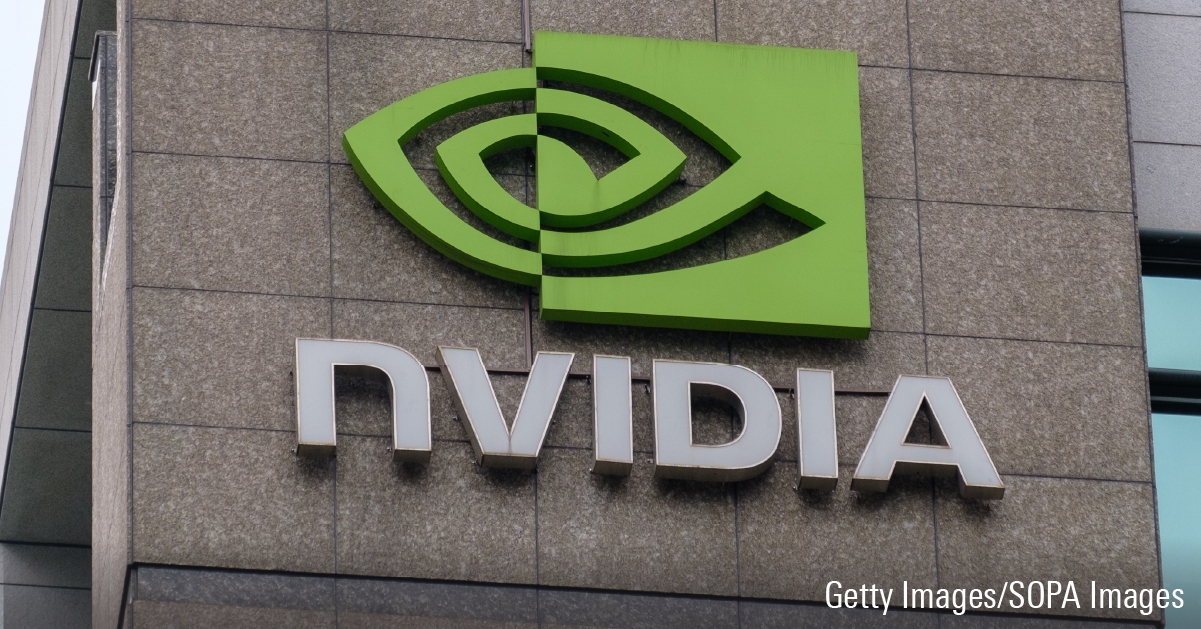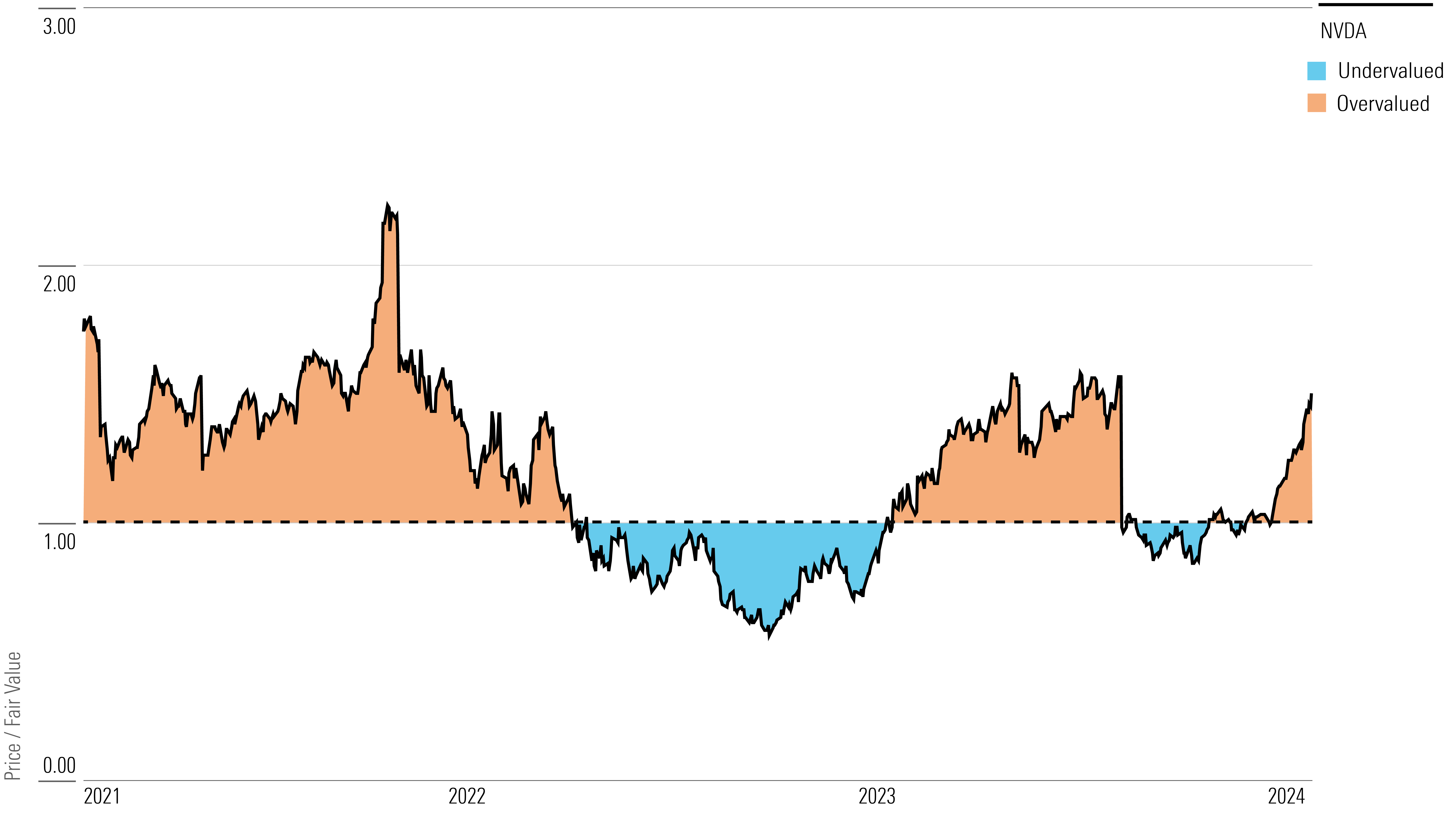Going Into Earnings, Is Nvidia a Buy, a Sell, or Fairly Valued?
With data centers dominating revenue, here’s what we think of Nvidia’s stock.

Nvidia NVDA is set to release its fourth-quarter earnings report on Feb. 21, after the market close. Here’s Morningstar’s take on what to look for in Nvidia’s earnings and stock.
Key Morningstar Metrics for Nvidia
- Fair Value Estimate: $480.00
- Morningstar Rating: 2 stars
- Morningstar Economic Moat Rating: Wide
- Morningstar Uncertainty Rating: Very High
What to Watch for In NVIDIA’s Q4 Earnings
The data center segment remains in focus
- This business dominates Nvidia’s revenue, earnings, and valuation. The company has continued to smash through its prior guidance and lift its estimates for the coming quarter. We anticipate more of the same.
- The biggest factors putting a ceiling on Nvidia’s earnings are supply constraints, and we’ll be interested in any commentary about whether (or how rapidly) the firm’s manufacturing partners are expanding to satisfy demand for its AI GPUs.
Artificial intelligence will be top of mind
We see many moving pieces within the AI market for Nvidia and its peers. Some questions we have:
- What impact have U.S. restrictions on AI accelerator sales into China had? What progress has Nvidia made in ensuring its new products are compliant? In the meantime, will the restrictions make a dent in the firm’s growth trajectory?
- What is the demand from nation-states? It appears sovereign governments are buying Nvidia GPUs to build supercomputers. How much will this contribute to revenue growth?
- What is the size of the AI accelerator market? Advanced Micro Devices AMD stunningly lifted its forecast for the 2027 industry total addressable market to $400 billion from $150 billion. This includes other types of chips besides GPUs but still implies massive GPU growth, and Nvidia still dominates the AI GPU space.
- What capital expenditure is Nvidia seeing in the data center? Mega-cap tech companies have lifted their spending plans for AI in 2024, and cloud leaders might buy many more GPUs than what the market anticipates over the next few years.
Reuters recently reported that Nvidia is building a custom chip design unit that might help build specialized AI chips for others. We’ll be interested in any insight around this initiative, and the opportunities it might open for Nvidia.
All these items will help us inform our estimates for future data center revenue growth, and in turn free cash flow generation and our fair value estimate.
Nvidia Stock Price
Fair Value Estimate for Nvidia
With its 2-star rating, we believe Nvidia’s stock is overvalued compared with our long-term fair value estimate of $480 per share, which implies an equity value of over $1.1 trillion, a fiscal 2024 price/adjusted earnings multiple of 45 times, and a fiscal 2025 forward price/adjusted earnings multiple of 31 times.
Our fair value estimate (and Nvidia’s stock price) will be driven by its prospects in the data center segment and AI GPUs, for better or worse. We anticipate a massive expansion in the AI processor market in the decade ahead, and we see room for tremendous revenue growth both at Nvidia and for competing solutions from either external chipmakers (like AMD or Intel INTC) or in-house solutions developed by hyperscalers (such as chips from Alphabet GOOGL, Amazon AMZN, or others).
Nvidia’s data center business has already achieved exponential growth, rising from $3 billion in fiscal 2020 to $15 billion in fiscal 2023. The firm should see an even higher inflection point in fiscal 2024, as we expect data center revenue to more than double to $41 billion. We don’t view this spike as coming from frontloaded orders or a buildup of excess capacity, as we model 46% growth in fiscal 2025 data center revenue to over $60 billion. We model growth of 23%, 20%, and 13% in the following three years, driving the segment’s revenue to $100 billion in fiscal 2028. We doubt that any enterprise wants to be left behind, nor does any cloud computing provider want to be shorthanded when providing AI GPUs to customers.
Read more about Nvidia’s fair value estimate.
NVIDIA Historical Price/Fair Value Ratio]

Economic Moat Rating
We assign Nvidia a wide moat thanks to intangible assets around its graphics processing units and, increasingly, switching costs around its proprietary software. This includes the Cuda platform for AI tools, which lets developers use Nvidia’s GPUs to build AI models.
Nvidia was an early leader and designer of GPUs, which were originally developed to offload graphic processing tasks on PCs and gaming consoles. The firm has emerged as the clear market share leader in discrete GPUs (it has a share of over 80%, per Mercury Research). We attribute this leadership to intangible assets associated with GPU design, as well as the associated software, frameworks, and tools developers need to work with these GPUs. In our view, recent introductions like ray-tracing technology and the use of AI tensor cores in gaming applications are signs Nvidia has not lost its GPU leadership in any way. The firm’s average selling prices are often twice as high as those of its closest competitor, AMD.
Meanwhile, we don’t foresee any companies becoming a third relevant player in the GPU market. Even Intel, the chip industry behemoth, has struggled for many years to build a high-end GPU that would be adopted by gaming enthusiasts; its next effort at a discrete GPU is slated to launch in 2025. We do see integrated GPU functionality within many of Intel’s PC processors. We perceive such integrated solutions as “good enough” for nongamers but not on par with high-end GPU needs.
Read more about Nvidia’s moat rating.
Risk and Uncertainty
We assign Nvidia an Uncertainty Rating of Very High. The firm is an industry leader in GPUs used in AI model training, and it has carved out a good portion of demand for chips used in AI inference workloads (which involves running a model to make a prediction or output).
We see a host of tech leaders vying for this leading AI position. We think it is inevitable that leading hyperscale vendors, such as Amazon’s AWS, Microsoft MSFT, Google, and Meta Platforms META, will seek to reduce their reliance on Nvidia and diversify their semiconductor and software supplier base, including the development of in-house solutions. Google’s TPUs and Amazon’s Trainium and Inferentia chips were designed with AI workloads in mind, while Microsoft and Meta have announced semiconductor design plans. Among existing semiconductor vendors, AMD is quickly expanding its GPU lineup to serve cloud leaders. Intel also has AI accelerator products, and it will likely remain focused on this opportunity.
Read more about Nvidia’s risk and uncertainty.
NVDA Bulls Say
- Nvidia’s GPUs offer industry-leading parallel processing, which was historically needed in PC gaming applications but has expanded into crypto mining, AI, and perhaps other future applications.
- Nvidia’s data center GPUs and Cuda software platform have established the company as the dominant vendor for AI model training, which is a use case that should rise exponentially in the years ahead.
- The firm has a first-mover advantage in the autonomous driving market that could lead to widespread adoption of its Drive PX self-driving platform.
NVDA Bears Say
- Nvidia is a leading AI chip vendor today, but other powerful chipmakers and tech titans are focused on in-house chip development.
- Although Cuda is preeminent in AI training software and tools, leading cloud vendors would likely prefer to see greater competition in this space and may shift to alternative open-source tools if they were to arise.
- Nvidia’s gaming GPU business has often seen boom-or-bust cycles based on PC demand, and more recently cryptocurrency mining as well.
This article was compiled by Quinn Rennell.
The author or authors own shares in one or more securities mentioned in this article. Find out about Morningstar’s editorial policies.

/s3.amazonaws.com/arc-authors/morningstar/5c8852db-04a9-4ec5-8527-9107fff80c09.jpg)
/cloudfront-us-east-1.images.arcpublishing.com/morningstar/ECVXZPYGAJEWHOXQMUK6RKDJOM.jpg)
/cloudfront-us-east-1.images.arcpublishing.com/morningstar/KOTZFI3SBBGOVJJVPI7NWAPW4E.jpg)
/cloudfront-us-east-1.images.arcpublishing.com/morningstar/V33GR4AWKNF5XACS3HZ356QWCM.jpg)
:quality(80)/s3.amazonaws.com/arc-authors/morningstar/5c8852db-04a9-4ec5-8527-9107fff80c09.jpg)